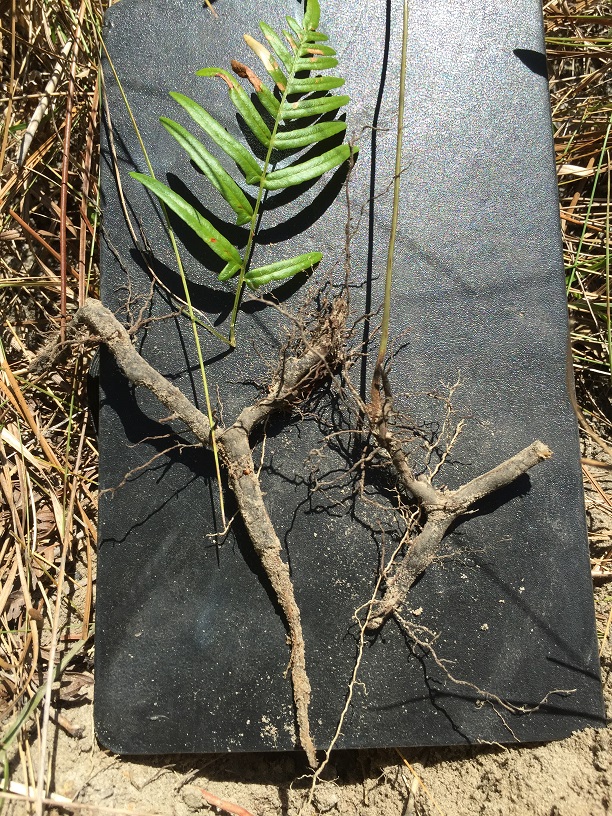Difference between revisions of "Pteridium aquilinum"
(→Seed dispersal) |
Lsandstrum (talk | contribs) |
||
| Line 28: | Line 28: | ||
===Habitat=== <!--Natural communities, human disturbed habitats, topography, hydrology, soils, light, fire regime requirements for removal of competition, etc.--> | ===Habitat=== <!--Natural communities, human disturbed habitats, topography, hydrology, soils, light, fire regime requirements for removal of competition, etc.--> | ||
''Pteridium aquilinum'' is restricted to native groundcover with a statistical affinity in upland pinelands of South Georgia. <ref name=oster> Ostertag, T.E., and K.M. Robertson. 2007. A comparison of native versus old-field vegetation in upland pinelands managed with frequent fire, South Georgia, USA. Pages 109–120 in R.E. Masters and K.E.M. Galley (eds.). Proceedings of the 23rd Tall Timbers Fire Ecology Conference: Fire in Grassland and Shrubland Ecosystems. </ref> | ''Pteridium aquilinum'' is restricted to native groundcover with a statistical affinity in upland pinelands of South Georgia. <ref name=oster> Ostertag, T.E., and K.M. Robertson. 2007. A comparison of native versus old-field vegetation in upland pinelands managed with frequent fire, South Georgia, USA. Pages 109–120 in R.E. Masters and K.E.M. Galley (eds.). Proceedings of the 23rd Tall Timbers Fire Ecology Conference: Fire in Grassland and Shrubland Ecosystems. </ref> | ||
| + | ''P. aquilinum'' displays a negative response to agricultural soil distrubance in South Carolinian old growth longleaf forests.<ref>Brudvig, L.A. and E.I. Damchen. (2011). Land-use history, historical connectivity, and land management interact to determine longleaf pine woodland understory richness and composition. Ecography 34: 257-266.</ref> | ||
<!-- ===Phenology===--> <!--Timing off flowering, fruiting, seed dispersal, and environmental triggers. Cite PanFlora website if appropriate: http://www.gilnelson.com/PanFlora/ --> | <!-- ===Phenology===--> <!--Timing off flowering, fruiting, seed dispersal, and environmental triggers. Cite PanFlora website if appropriate: http://www.gilnelson.com/PanFlora/ --> | ||
| + | |||
===Seed dispersal=== | ===Seed dispersal=== | ||
This species is thought to be dispersed by wind.<ref>Kirkman, L. Katherine. Unpublished database of seed dispersal mode of plants found in Coastal Plain longleaf pine-grasslands of the Jones Ecological Research Center, Georgia.</ref> | This species is thought to be dispersed by wind.<ref>Kirkman, L. Katherine. Unpublished database of seed dispersal mode of plants found in Coastal Plain longleaf pine-grasslands of the Jones Ecological Research Center, Georgia.</ref> | ||
Revision as of 17:27, 27 June 2019
| Pteridium aquilinum | |
|---|---|

| |
| Photo by Kevin Robertson | |
| Scientific classification | |
| Kingdom: | Plantae |
| Division: | Tracheophyta- Vascular plants |
| Class: | Polypodiopsida - Leptosporangiate ferns |
| Order: | Polypodiales |
| Family: | Dennstaedtiaceae |
| Genus: | Pteridium |
| Species: | P. aquilinum |
| Binomial name | |
| Pteridium aquilinum (L.) Kuhn | |

| |
| Natural range of Pteridium aquilinum from USDA NRCS Plants Database. | |
Common names: Brakenfern
Contents
Taxonomic notes
Description
A description of Pteridium aquilinum is provided in The Flora of North America.
Distribution
Ecology
Habitat
Pteridium aquilinum is restricted to native groundcover with a statistical affinity in upland pinelands of South Georgia. [1] P. aquilinum displays a negative response to agricultural soil distrubance in South Carolinian old growth longleaf forests.[2]
Seed dispersal
This species is thought to be dispersed by wind.[3]
Conservation and management
Cultivation and restoration
Photo Gallery
References and notes
- ↑ Ostertag, T.E., and K.M. Robertson. 2007. A comparison of native versus old-field vegetation in upland pinelands managed with frequent fire, South Georgia, USA. Pages 109–120 in R.E. Masters and K.E.M. Galley (eds.). Proceedings of the 23rd Tall Timbers Fire Ecology Conference: Fire in Grassland and Shrubland Ecosystems.
- ↑ Brudvig, L.A. and E.I. Damchen. (2011). Land-use history, historical connectivity, and land management interact to determine longleaf pine woodland understory richness and composition. Ecography 34: 257-266.
- ↑ Kirkman, L. Katherine. Unpublished database of seed dispersal mode of plants found in Coastal Plain longleaf pine-grasslands of the Jones Ecological Research Center, Georgia.
